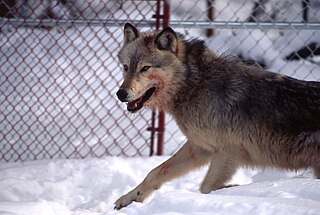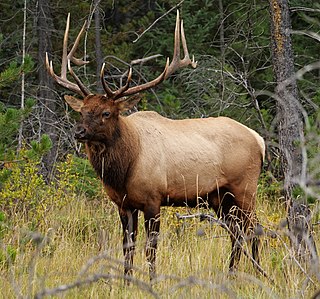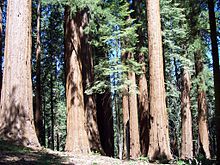
Yellowstone National Park is a national park of the United States located in the northwest corner of Wyoming and extending into Montana and Idaho. It was established by the 42nd U.S. Congress through the Yellowstone National Park Protection Act and signed into law by President Ulysses S. Grant on March 1, 1872. Yellowstone was the first national park in the U.S. and is also widely held to be the first national park in the world. The park is known for its wildlife and its many geothermal features, especially the Old Faithful geyser, one of its most popular. While it represents many types of biomes, the subalpine forest is the most abundant. It is part of the South Central Rockies forests ecoregion.

The National Park Service (NPS) is an agency of the United States federal government, within the US Department of the Interior. The service manages all national parks; most national monuments; and other natural, historical, and recreational properties, with various title designations. The United States Congress created the agency on August 25, 1916, through the National Park Service Organic Act. Its headquarters is in Washington, D.C., within the main headquarters of the Department of the Interior.

The Greater Yellowstone Ecosystem (GYE) is one of the last remaining large, nearly intact ecosystems in the northern temperate zone of the Earth. It is located within the northern Rocky Mountains, in areas of northwestern Wyoming, southwestern Montana, and eastern Idaho, and is about 22 million acres (89,000 km2). Yellowstone National Park and the Yellowstone Caldera 'hotspot' are within it.

Wildlife management is the management process influencing interactions among and between wildlife, its habitats and people to achieve predefined impacts. Wildlife management can include wildlife conservation, population control, gamekeeping, wildlife contraceptive and pest control.

The National Elk Refuge is a Wildlife Refuge located in Jackson Hole in the U.S. state of Wyoming. It was created in 1912 to protect habitat and provide sanctuary for one of the largest elk herds. With a total of 24,700 acres (10,000 ha), the refuge borders the town of Jackson, Wyoming, on the southwest, Bridger-Teton National Forest on the east and Grand Teton National Park on the north. It is home to an average of 7,500 elk each winter. The refuge is managed by the U.S. Fish and Wildlife Service, an agency of the U.S. Department of the Interior.

Wolf reintroduction involves the reintroduction of a portion of grey wolves in areas where native wolves have been extirpated. More than 30 subspecies of Canis lupus have been recognized, and grey wolves, as colloquially understood, comprise nondomestic/feral subspecies. Reintroduction is only considered where large tracts of suitable wilderness still exist and where certain prey species are abundant enough to support a predetermined wolf population.

The elk or wapiti, is the second largest species within the deer family, Cervidae, and one of the largest terrestrial mammals in its native range of North America and Central and East Asia. The word "elk" originally referred to the European variety of the moose, Alces alces, but was transferred to Cervus canadensis by North American colonists.

The Yellowstone fires of 1988 collectively formed the largest wildfire in the recorded history of Yellowstone National Park in the United States. Starting as many smaller individual fires, the flames quickly spread out of control due to drought conditions and increasing winds, combining into several large conflagrations which burned for several months. The fires almost destroyed two major visitor destinations and, on September 8, 1988, the entire park was closed to all non-emergency personnel for the first time in its history. Only the arrival of cool and moist weather in the late autumn brought the fires to an end. A total of 793,880 acres (3,213 km2), or 36 percent of the park, burned at varying levels of severity.

Aldo Starker Leopold was an American author, forester, zoologist and conservationist. Leopold served as a professor at the University of California, Berkeley, for thirty years within the Zoology, Conservation, and Forestry departments. Throughout his life, Leopold was a public face for science. He was active in numerous wildlife and conservation groups and made significant research contributions in ornithology, mammalogy, and wildlife ecology. Leopold is notable for his ecosystem management paper, the Leopold Report, and his considerable presence in some of the most controversial wildlife issues, including national park wildlife policy, predator control, wildlife refuge, and fire policy.

Olaus Johan Murie, called the "father of modern elk management", was a naturalist, author, and wildlife biologist who did groundbreaking field research on a variety of large northern mammals. Rather than conducting empirical experiments, Murie practiced a more observational-based science.
Wildfire suppression in the United States has had a long and varied history. For most of the 20th century, any form of wildland fire, whether it was naturally caused or otherwise, was quickly suppressed for fear of uncontrollable and destructive conflagrations such as the Peshtigo Fire in 1871 and the Great Fire of 1910. In the 1960s, policies governing wildfire suppression changed due to ecological studies that recognized fire as a natural process necessary for new growth. Today, policies advocating complete fire suppression have been exchanged for those who encourage wildland fire use, or the allowing of fire to act as a tool, such as the case with controlled burns.

George Meléndez Wright was an American biologist who conceived of, then conducted, the first scientific survey of fauna for the National Park Service between 1929 and 1933. Wright was a pioneer in many ways, but especially for his holistic approach to wildlife management issues in the National Parks. Wright and his colleagues spent years in the field researching wildlife issues, and advocating for an ecosystem-wide approach to managing species within, and bordering, the parks. The George Wright Society, founded in 1980, honors Wright's vision.

The history of wolves in Yellowstone includes the extirpation, absence and reintroduction of wild populations of the gray wolf to Yellowstone National Park and the Greater Yellowstone Ecosystem. When the park was created in 1872, wolf populations were already in decline in Montana, Wyoming and Idaho. The creation of the national park did not provide protection for wolves or other predators, and government predator control programs in the first decades of the 1900s essentially helped eliminate the gray wolf from Yellowstone. The last wolves were killed in Yellowstone in 1926. After that, sporadic reports of wolves still occurred, but scientists confirmed in the mid-1900s that sustainable gray wolf populations had been extirpated and were absent from Yellowstone as well as 48 states.

The bibliography of Yellowstone National Park identifies English language historic, scientific, ecological, cultural, tourism, social, and advocacy books, journals and studies on the subject of Yellowstone National Park topics published since 1870 and documented in Yellowstone related bibliographies and other related references.

Grebe Lake is a 156 acres (0.63 km2) backcountry lake in Yellowstone National Park most noted for its population of Arctic grayling. Grebe Lake comprises the headwaters of the Gibbon River. Grebe Lake is located approximately 3.1 miles (5.0 km) north of the Norris-Canyon section of the Grand Loop Road. The trail to the lake passes through mostly level Lodgepole Pine forest and open meadows. The lake was named by J.P. Iddings, a geologist with the Arnold Hague geologic surveys. There are four backcountry campsites located on the lake.

Shoshone Lake is a U.S. backcountry lake with an area of 8,050 acres with an elevation of 7,795 feet (2,376 m) in the southwest section of Yellowstone National Park, Wyoming. It lies at the headwaters of the Lewis River, a tributary of the Snake River. The U.S. Fish and Wildlife Service believes that Shoshone Lake is the largest backcountry lake in the lower 48 states that cannot be reached by a road. The Yellowstone Caldera is located within the lake.

The ecology of the Rocky Mountains is diverse due to the effects of a variety of environmental factors. The Rocky Mountains are the major mountain range in western North America, running from the far north of British Columbia in Canada to New Mexico in the southwestern United States, climbing from the Great Plains at or below 1,800 feet (550 m) to peaks of over 14,000 feet (4,300 m). Temperature and rainfall varies greatly also and thus the Rockies are home to a mixture of habitats including the alpine, subalpine and boreal habitats of the Northern Rocky Mountains in British Columbia and Alberta, the coniferous forests of Montana and Idaho, the wetlands and prairie where the Rockies meet the plains, a different mix of conifers on the Yellowstone Plateau in Wyoming, the montane forests of Utah, and in the high Rockies of Colorado and New Mexico, and finally the alpine tundra of the highest elevations.

The conservation of bison in North America is an ongoing, diverse effort to bring American bison back from the brink of extinction. Plains bison, a subspecies, are a keystone species in the North American Great Plains. Bison are a species of conservation concern in part because they suffered a severe population bottleneck at the end of the 19th century. The near extinction of the species during the 19th century unraveled fundamental ties between bison, grassland ecosystems, and indigenous peoples’ cultures and livelihoods. English speakers used the word buffalo for this animal when they arrived. Bison was used as the scientific term to distinguish them from the true buffalo. Buffalo is commonly used as it continues to hold cultural significance, particularly for Indigenous people.




















